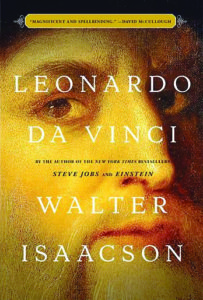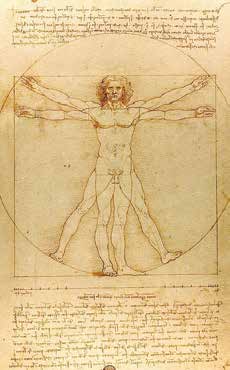Leonardo da Vinci

BY WALTER ISAACSON
SIMON & SCHUSTER, 2017
624 PP.; $35.00
“Leonardo was a genius,” Walter Isaacson says near the end of Leonardo da Vinci. “Yet it is also true that he was a mere mortal.” Ironically, the author’s fine, scrupulous biography makes one wonder whether his protagonist’s brilliance was of such magnitude that he had to be a member of a species superior to Homo sapiens.
I shall henceforth call the book’s subject Leonardo, as Isaacson does. If he had a surname in the modern sense of the word it is unknown; da Vinci simply means “from Vinci,” a town seventeen miles from Florence, Italy. Leonardo was born out of wedlock in 1452, into a family of notaries. His mother, Caterina, was an “orphaned and impoverished sixteen-year-old” who would eventually marry a kiln worker. They and Leonardo’s paternal grandfather raised the boy. Leonardo was, for the most part, an autodidact; the only institutional education he received was, as a youth, at a so-called abacus school, where he was exposed mostly to commercial math, to no great avail. Isaacson thinks this was ultimately a good thing—that Leonardo was never constrained by the mistakes of antecedent savants.
When Leonardo was about fourteen his biological father used his connections to apprentice his son in the studio of Andrea del Verrocchio, a successful artist who lived in Florence. At the time the city, though nominally a republic, was really a plutocracy dominated by the Medici family, bankers and great patrons of the arts. It was a vibrant, cultured, exciting Renaissance metropolis, a splendid place for an aspiring artist like Leonardo. While he was, to a great extent, his own best teacher, Leonardo did study important subjects in Verrocchio’s workshop: drawing, anatomy, chiaroscuro (“the use of contrasts of light and shadow” in art), sfumato (blurring the sharp edges in a painting), and perhaps most important, geometry (geometric imagery was integral to his artistic, engineering, and scientific endeavors). Moreover, in Verrocchio’s atelier the projects were worked on collectively. This appealed to Leonardo; later, when he acquired apprentices, he enjoyed working with them on much of his artwork (to the despair of future collectors and art historians).
Right before Leonardo turned twenty-four, he twice faced legal sanctions in Florence for homosexual behavior. The penalties could have been severe, but the charges were dropped for lack of evidence. Interestingly for that time and culture, Leonardo didn’t experience his homosexuality as a psychological burden: “He seemed to be fine with [it],” Isaacson observes. “He made no effort to hide or proclaim it, but it probably contributed to his sense of being unconventional….Over the years he would have many beautiful young men as part of his studio and household”—and his art. It seems reasonable to assume that there was a connection between Leonardo’s sexual preferences and the comely androgynous figures in many of his paintings, including the religious ones.
In 1482 Lorenzo de’ Medici (“the Magnificent”), the “de facto ruler of Florence,” dispatched Leonardo to Milan as part of a diplomatic mission. He remained there for seventeen years. The city was ruled by Ludovico Sforza, whom Isaacson describes as ruthless. As it happened, Leonardo had “a fondness for strong leaders.” Isaacson suggests it was because autocrats were the most likely, in the Italy of that era, to provide a “comfortable retainer,” and, too, that Leonardo was attracted to power. (Another of Leonardo’s benefactors was Cesare Borgia—the infamous tyrant and model for Machiavelli’s The Prince—whose relationship to humane behavior was exiguous.)
After arriving in Milan, Leonardo sent a job application to Ludovico, promoting his prowess as a military technologist (which had no basis in fact at the time). Ludovico ignored the importuning and utilized him for many years as a designer of pageants. This might sound demeaning, but Leonardo adored working on such projects; he cherished their combination of art and technology. After seven years in Milan, Isaacson reports Leonardo finally secured “an official appointment at court, with a salary and accommodations.”

Leonardo believed that if his intellectual inquiries contradicted Christian dogma, his inquiries were more valid.
In 1495 Ludovico enlisted Leonardo to paint a New Testament scene on a refectory wall in the Santa Maria delle Grazie church: The Last Supper. It took three years to complete, and the result, Isaacson contends, “is the most spellbinding narrative painting in history.” Alas, the artist’s techniques for binding the paint to the wall led to the onset of his great work’s deterioration in twenty years. Attempts at restoration in subsequent centuries have often done more harm than good. Ludovico also commissioned a massive equestrian statue from Leonardo. He worked on plans for the assignment, but the statue was never constructed. This aborted commission indicates a recurrent them in Leonardo’s career: he was wont, more often than not, to leave commissioned works incomplete. Moreover, he was quite averse to delivering even “finished” projects (the Mona Lisa was one) to those who had contracted for them. He would carry many of these executed artworks with him during his peregrinations and compulsively refine them over the years.
As for Leonardo’s post-Milan activities, he sojourned again in Florence (where he began the Mona Lisa), Milan again, Rome, and finally, in 1516, France, where King Francis I “would be his final and most devoted patron.” Leonardo died in France in 1519 at the age of sixty-seven.
There is so much to say about Leonardo’s life and oeuvre that I’ve been compelled to make harsh decisions on what not to discuss in this review (but rest assured that Isaacson skips and skimps on nothing). I’m assuming that readers of this journal are knowledgeable about Leonardo’s most famous works of art—The Last Supper, the Mona Lisa, Virgin and Child with Saint Anne, et al.—so I will touch on some other aspects of his life that might be less familiar. First, what was Leonardo the man like? Isaacson had to turn to his subject’s contemporaries and near contemporaries to get a sense of this, because Leonardo was steadfastly consistent throughout his lifetime about revealing next to nothing about himself. Still, the author’s research does give us a sense, at least, of Leonardo’s personality.
By the time of his first visit to Milan he was notable for his “good looks, muscular build, and gentle personal style.” He had “many close friends,” including “prominent intellectuals.” And he was unselfish, always willing to share what he had with others—he was uninterested in amassing wealth beyond what was needed to pleasantly sustain himself and his posse. In short, he was a charmer, which must have been useful when coping with vicious ruffians like Ludovico Sforza and Cesare Borgia.
The other facet of Leonardo’s life that I want to call to the reader’s attention are his incredible notebooks. Isaacson writes that “My starting point for this book was not Leonardo’s art masterpieces but his notebooks. His mind, I think, is best revealed in them.” The author persuaded me. Leonardo commenced note taking in the 1480s, after moving to Milan, and continued for the rest of his life. There are more than 7,200 pages still surviving, which Isaacson estimates is “about one-quarter of what Leonardo actually wrote.” What was in them? Everything, or close to it. Plans, hypotheses, ideas ad infinitum.
Scribbled in the margins were to-do lists, records of expenses, and sketches of people…Over the years, as his scientific study got more serious, he filled pages with outlines and passages for treatises on topics such as flight, water, anatomy, art, horses, mechanics and geology. About the only thing missing are personal revelations and intimacies.
Virtually none of this remarkable work was published in Leonardo’s lifetime. Incidentally, there’s a prevailing notion that the notebooks were written “in code, to keep his writings secret” given the fact that Leonardo wrote “from right to left and drew each letter facing backward.” Not true, says Isaacson, noting that Leonardo was left-handed and wrote the way he did “because when using his left hand he could glide leftward across the page without smudging the ink.”
Leonardo saw analogies everywhere; he was beguiled by the manifold manifestations of motion; he was dedicated to using technology to improve society (he designed flying machines long before the expertise existed to construct them); and he was infatuated with physiology, human and otherwise. The notebooks are replete with all of these—and more. But what I find especially enthralling about the notebooks is that the artist didn’t stint on his artistry when rendering the drawings in them: they are as fastidious and subtle, exquisite and haunting, as Leonardo’s major works of art.
The pages of Leonardo da Vinci are of glossy stock, so that the art and drawings interspersed throughout the book can be shown to their best advantage. They are expertly reproduced but the glossiness makes the book quite heavy and awkward to hold and handle. That’s probably my main complaint about this book. (Some nitpicking: I found it jarring when the author refers to Leonardo as “gay.” The word is anachronistic in this context because it didn’t acquire its association with homosexuality until the early twentieth century.)
The highest praise I can pay Isaacson is that his biography does justice to a man who was probably the supreme Renaissance Man. Near the beginning of the book, he writes that “we should be wary of that word [genius]. Slapping the ‘genius’ label on Leonardo oddly minimizes him by making it seem as if he were touched by lightning.” I agree: calling someone a genius is, I suspect, all too often a way for conventional wisdom to eschew learning about all the hard work, intensity, and contemplation that mind-boggling minds wield to create their masterpieces (artistic, scientific, philosophical, etc). Isaacson spends a large part of his book painstakingly explaining characteristics of Leonardo’s paintings and drawings. Many readers might find these lucubrations tedious and be tempted to skip them. I would urge those readers not to do so, because it’s in these exegeses that Isaacson reveals why Leonardo was, in fact, the particular genius he was, how his boundless interests influenced each other. (Another cavil: the book’s conclusion contains lessons from Leonardo’s life such as “retain a childlike sense of wonder,” “go down rabbit holes,” “get distracted,” and the like. Suffice it to say that these maxims aren’t on the same level of sophistication as the rest of Leonardo da Vinci’s perceptive insights.)
Humanist readers are probably wondering: Was Leonardo a humanist as we understand the word today? Based on the evidence in Leonardo da Vinci, one must, I think, conclude that he wasn’t an atheist, but the book makes a good case that he was far from pious. “Leonardo was disinterested [sic] in personal religious practice” it notes, and “was not strongly religious.” Also, Leonardo believed that if his intellectual inquiries contradicted Christian dogma, his inquiries were more valid: “His science led him to adopt many heretical beliefs, including that the fetus in the womb does not have a soul of its own and that the biblical Flood did not happen.” (The latter conviction was grounded in his study of fossils.) Isaacson describes Leonardo at one point as a humanist and although he doesn’t define the word, the context leads me to assume that it means, for him, one who apprehends and appreciates humanity. If I’m correct, Isaacson’s humanist locution constitutes an implicit affirmative to my question. But I shall leave the almost-last word to Leonardo: “As a well-spent day brings a happy sleep, so a well-employed life brings a happy death.” Sounds like a humanist—in every sense of the word—to me.
